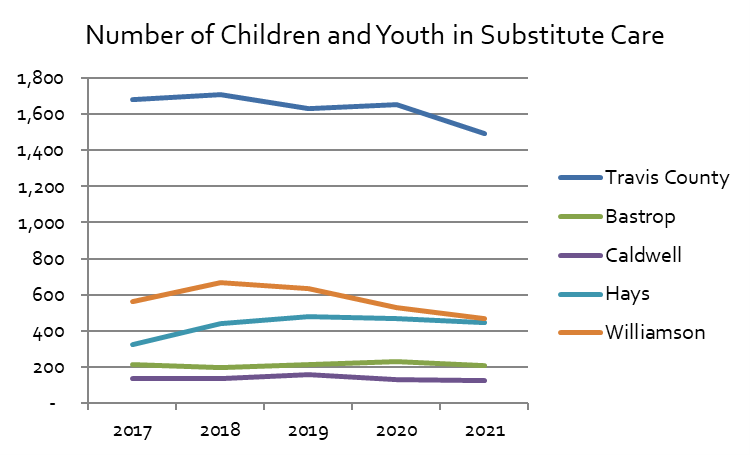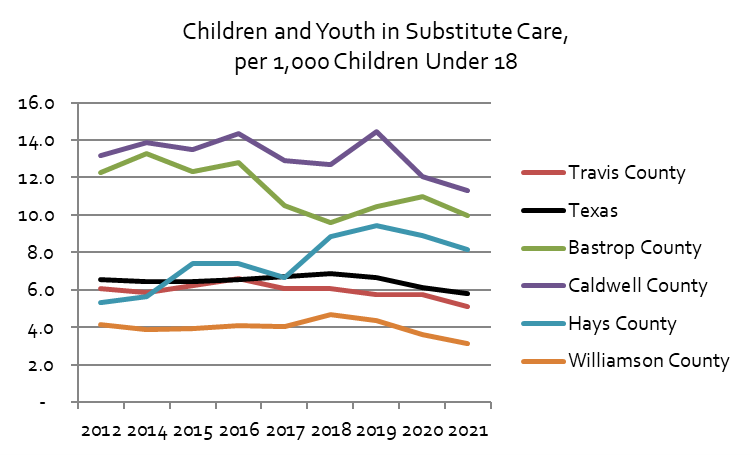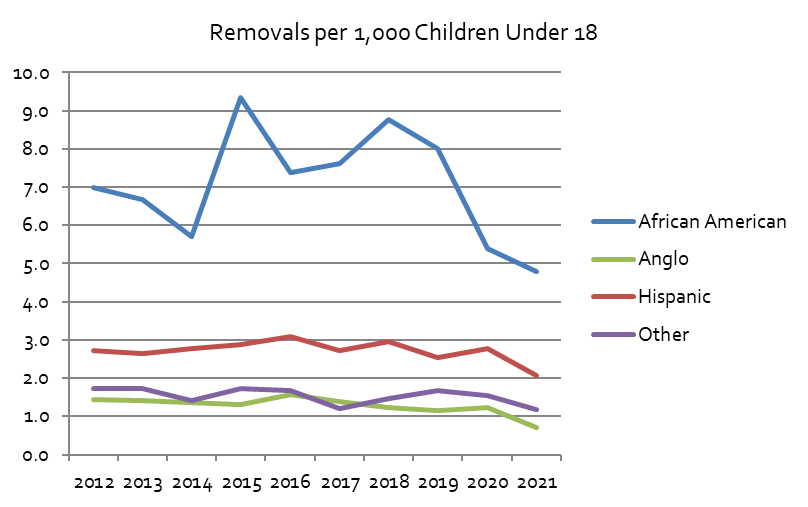Children and Youth in Substitute Care
Indicator: Children and Youth In Substitute Care
Progress: In 2021, 1,492 children in Travis County lived in substitute care, equal to about 5 per 1,000 children under 18
Significance of Indicator: Children and youth who have experienced maltreatment are sometimes placed in substitute care when they cannot be cared for by their primary caregivers.
what the data tell us
In 2021, the rate of children who are placed in substitute care outside of their home decreased slightly from the previous year. From 2012 to 2016 the rate increased slightly, before beginning a declining trend that continued in 2021. From 2014 to 2016, there was an increase in the number of children and youth in substitute care in Travis County reaching a maximum of 1,796. In all but one year since 2008, Travis County has had a lower rate of children living in substitute care than the state as a whole. Children in substitute care are the legal responsibility of the Texas Department of Family and Protective Services and have been placed outside of the home. In 2021, 1,492 children and youth in Travis County and 44,284 children in Texas were living in substitute care.

Definition: Children and Youth who are the legal responsibility of the Texas Department of Family and Protective Services who are removed and placed outside their own home per 1,000 children under 18
Data Source: Texas Department of Family and Protective Services Annual Data Book
Data Considerations: Substitute care includes foster homes, institutions, foster group homes, residential treatment facilities, hospitals, adoptive homes, juvenile facilities, kinship care placements, and independent living arrangements. Foster care is a subset of substitute care. This figure also includes a small number of youth between the ages of 18 and 22. These youth have aged out of DFPS’ legal responsibility, but may remain in foster care until they complete vocational training (by age 19) or high school (by age 22).
The story behind the indicator
Children who cannot remain in their own homes due to maltreatment following an investigation by the Department of Family and Protective Services may be removed and placed in substitute care. This includes foster homes, institutions, foster group homes, residential treatment facilities, hospitals, adoptive homes, juvenile facilities, kinship care placements, and independent living arrangements.
The rate of children who are placed in substitute care outside of their home declined from 2007 to 2010 before leveling-off through 2014. From 2014 to 2016, there was an increase in the number of children and youth in substitute care in Travis County reaching a maximum of 1,796. In all but one year since 2008, Travis County has had a lower rate of children living in substitute care than the state as a whole. Reductions in substitute care placements may result from a variety of factors, including lower rates of maltreatment, increased use of family-based services, or a greater number of maltreated children being successfully re-integrated into their homes.
Although placement in a stable, permanent home is the goal of the Department of Family and Protective Services, some youth remain in substitute care until they ‘age out’ of foster care and transition to independent living. According to research cited by Texans Care for Children, youth aging-out of foster care experience a number of negative outcomes, including poor employment outcomes, low incomes, homelessness, poor mental health, and higher rates of incarceration.
children & youth in Substitute Care, by County
Bastrop and Caldwell Counties have a higher share of their child populations living in substitute care than the state of Texas and other local counties. A lower share of children live in substitute care in Hays, Travis, and Williamson Counties than in the state as a whole. Nevertheless, Travis County, the most populous local county, has the highest number of children living in substitute care– 1,492.

Definition: Children and Youth who are the legal responsibility of the Texas Department of Family and Protective Services who are removed and placed outside their own home per 1,000 children under 18
Data Source: Texas Department of Family and Protective Services Annual Data Book
Data Considerations: Substitute care includes foster homes, institutions, foster group homes, residential treatment facilities, hospitals, adoptive homes, juvenile facilities, kinship care placements, and independent living arrangements. Foster care is a subset of substitute care. This figure also includes a small number of youth between the ages of 18 and 22. These youth have aged out of DFPS’ legal responsibility, but may remain in foster care until they complete vocational training (by age 19) or high school (by age 22).
Child Removals, by Race & Ethnicity, Travis County
African-American children are more likely than children of other races and ethnicities to be removed from their home by Child Protective Services, although this rate declined from 2011 to 2014, it increased to a high of 9.3 in 2015. The child removal rate for African American children has declined since, to a low of 4.8 African-American children per 1,000 children removed from their home in 2021. This is still over 4 times the removal rate of 0.7 Anglo children per 1,000. It is also significantly higher than the removal rates of 2.5 Hispanic children per 1,000, and 1.7 children of another race (not shown on the graph) per 1,000. Currently, the share of Hispanic children removed from their homes is at the lowest rate reported since 2012.

Definition: Rate of removals of children from their homes, by the Texas Department of Family and Protective Services, by race and ethnicity, per 1,000 children under 18
Data Source: Texas Department of Family and Protective Services Annual Data Book
Data Considerations: Data includes estimates from all stages of DFPS service delivery.
some local efforts to improve this indicator
Foster care redesign
Recommendations from a representative group of child welfare stakeholders in Texas are being implemented for a redesigned foster care system. They are focused on improving outcomes for children and families, including permanency outcomes. The quality indicators used as a foundation for the development of the redesign include many that will contribute to moving children through the system to permanency at a quicker pace. Children placed in their home communities, who live in a least restrictive environment supported by minimal moves, and maintain connections to family and other important people in the children’s lives are less likely to continue to move through the system. For more information about the redesign, visit: https://www.dfps.state.tx.us/Adoption_and_Foster_Care/About_Foster_Care/Foster_Care_Redesign/
Texas Christian University Institute of Child Development initiated a partnership with Mission Capital and other local nonprofits, funders, community activists and government agencies to lead a project aimed at improving our foster care system. The Travis County Collaborative for Children (TCCC) is an intensive, multi-year, multi-partner, multi-million-dollar initiative aimed at transforming the model of care for foster children and dramatically improving their lives.
Court Appointed Special Advocates (CASA) of Travis County
CASA (Court Appointed Special Advocates) of Travis County believes every child who’s been abused or neglected deserves to have a dedicated advocate speaking up for their best interest in court, at school and in the community. To accomplish this, CASA educates and empowers diverse community volunteers who ensure each child’s needs remain a priority in an over-burdened child welfare system. When the state steps in to protect a child’s safety because the people responsible for protecting them have not, a judge appoints a trained CASA volunteer to make independent and informed recommendations and help the judge decide what’s best for the child. CASA is the only child advocacy group working in the court system that provides a caring, consistent adult focused on the well-being of a single child. For more information, visit: casatravis.org
Substitute care placements in Austin/Travis County
There are multiple substitute care agencies in Austin/Travis County. Below is a list of some agencies and their websites where additional information can be obtained.
- Austin Children’s Shelter: Austin Children’s Shelter (ACS) provides a safe home and supportive services for children, youth and young adults from birth to 22 who have experienced significant loss, trauma, abuse and/or neglect in their lives. Most children at the Austin Children’s Shelter have been removed from their homes by Child Protective Services because of severe abuse or neglect. austinchildrenshelter.org
- Helping Hand Home for Children: Provides a nurturing and therapeutic home for children and to restore each child to a healthy family setting. Children, whose young lives were once filled with fear, pain, and chaos, are learning to trust adults to take care of them and reclaim their childhood. helpinghandhome.org
- Lifeworks: LifeWorks provides a safety net of support to more than 10,000 individuals every year. Realizing that every youth and every family is unique in their goals, talents and challenges, LifeWorks has developed a broad continuum of supportive services across the areas of Counseling, Housing, Education/Workforce and Youth Development. Clients may access one service, or they may enroll in multiple programs. Whether your goal is to go to college, heal from an abusive relationship, or develop your skills as a parent, service at LifeWorks begins by identifying strengths and ambitions. Large goals are broken down into smaller ones so that youth and families continually experience tangible progress towards concrete objectives and fulfillment of their potential. lifeworksaustin.org
- The Settlement Home: The Settlement Home provides a range services for children in foster care including foster homes, residential treatment and adoption services. settlementhome.org
- Lutheran Social Services: Improves the lives of children who have been removed from their families due to neglect and/or sexual, physical, or psychological abuse, by placing them in stable loving homes and providing therapeutic care as needed. Families are actively recruited and trained to foster basic needs children as well as large sibling groups, troubled teens, and children with special medical needs. fosterintexas.org
- Ripples of Hope for Children Ripples of Hope for Children removes the barriers to success of children in the child protective services, juvenile justice and mental health systems by strengthening and supporting families, connecting youth with services and opportunities, and creating community support. We engage community resources to help create a level playing field for these youth so that they have the same opportunities as others. ripplesofhopeforchildren.org
- Casey Family Programs- Austin office. Casey Family Programs’ main focus is to help young people from the public child welfare system find safe and permanent families by engaging in partnerships with the Texas Department of Family and Protective Services, juvenile court, and other allied community agencies; addressing the over-representation of children and youth of color in foster care; educating state representatives and other policy makers about the importance of safely reducing the number of children in foster care; and creating paths to permanency for those who do enter care. casey.org/Locations/Texas/Austin/

Definition: The number of students in the Austin Independent School District who were identified and counted as homeless by Project Help
Data Source: Project Help
Data Considerations: While Project Help works to serve homeless students within Austin ISD, identifying students who are experiencing homelessness is not so simple. If a student is not homeless at the time of enrollment and becomes homeless at some point during the school year, there is a chance that they would not be identified by the school district as being homeless.
2018 © Ready by 21 Austin
Ready by 21 (RB21) and the RB21 logo are registered trademarks of the Forum for Youth Investment. The Central Texas RB21 Coalition is a member of the Forum’s RB21 Learning Network. The Central Texas RB21 online dashboard is currently sponsored by Workforce Solutions — Capital Area Workforce Board, the Community Advancement Network (CAN) and the City of Austin, with content and data contributions from over 20 local youth-serving coalitions.
